Research Results
1. Plants use their epigenetic memories to adapt to climate change, scientists say
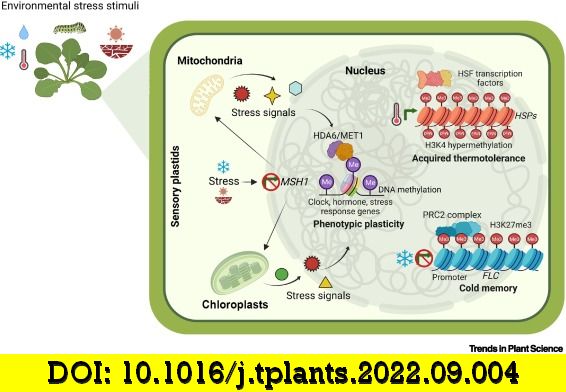 Animals can adapt quickly to survive adverse environmental conditions. Evidence is mounting to show that plants can, too. Researchers at the Department of Biology, University of Firenze, Firenze, Italy, led by Federico Martinelli, describe how plants quickly adapt to the adverse effects of climate change and how they pass these adaptations on to their offspring. Climate change is making winters shorter and shorter in many places, and plants are responding. Plants have developed complex molecular networks that allow them to remember, choose, and make decisions in response to stressful stimuli, even though they lack a nervous system. Because plants are sessile, they can exploit these networks to optimize their resources cost-effectively, and to maximize their fitness in response to multiple environmental stresses.
Animals can adapt quickly to survive adverse environmental conditions. Evidence is mounting to show that plants can, too. Researchers at the Department of Biology, University of Firenze, Firenze, Italy, led by Federico Martinelli, describe how plants quickly adapt to the adverse effects of climate change and how they pass these adaptations on to their offspring. Climate change is making winters shorter and shorter in many places, and plants are responding. Plants have developed complex molecular networks that allow them to remember, choose, and make decisions in response to stressful stimuli, even though they lack a nervous system. Because plants are sessile, they can exploit these networks to optimize their resources cost-effectively, and to maximize their fitness in response to multiple environmental stresses.
Even more interesting is the ability to pass this experience on to the next generation through epigenetic modifications that enhance classical genetic inheritance. Researchers present concepts and perspectives on the ability of plants to perceive, detect, remember, process, respond, and to some extent transmit information to their offspring to adapt more effectively to climate change. Through such mechanisms, plants can recognize the occurrence of a previous environmental situation and could respond more quickly when the same consequences occur. Going forward, Martinelli and his colleagues hope to understand more about the genes that are being passed down, an understanding that is especially important considering rapid climate change, which necessitates that every living organism, including plants, adapt quickly to survive.
Access the full paper at https://www.cell.com/trends/plant-science/fulltext/S1360-1385(22)00266-7?_returnURL=https%3A%2F%2Flinkinghub.elsevier.com%2Fretrieve%2Fpii%2FS1360138522002667%3Fshowall%3Dtrue
2. Scientists genetically engineer plants to yield more vegetable oil
Vegetable oil is essential in human nutrition and is also used in many important industrial applications. The demand for vegetable oil is growing rapidly in the world, and many countries have serious shortages. Coaxing oil plant species to produce more oil can help significantly reduce the oil budget. Scientists from the Nanyang Technological University of Singapore, led by Yong-Gui Gao, have successfully
genetically modified a plant protein responsible for the accumulation of oil in plant seeds and edible nuts. Most oil crops, such as oil palm, soybean, sunflower, canola, and groundnut, already have high oil content in their fruits or seeds, and it is difficult to increase their oil content by traditional crossing methods.
Increasing vegetable oil production can also contribute to the world’s pursuit of sustainable development by helping to reduce the amount of land needed to grow oil crops. The secret that helps plants store more oil in their seeds is one of their proteins, called WRINKLED1. Follow-up experiments showed that the oil content of modified Arabidopsis thaliana seeds contained more oil than unmodified seeds. Mutations of essential residues interacting with the DNA element affected its binding affinity and oil biosynthesis when these variants were transiently expressed in tobacco leaves. Seed oil content was improved in the stable transgenic wri1-1 expressing the AtWRI1 variant (W7R). Together, these findings provide a structural basis for elucidating WRI1 recognition and DNA binding, and they thus provide an alternative strategy to increase crop oil yield through WRI1 bioengineering.
Access the full paper at https://www.science.org/doi/10.1126/sciadv.abq1211
3. Chemists create an ‘artificial photosynthesis’ system ten times more efficient than existing systems
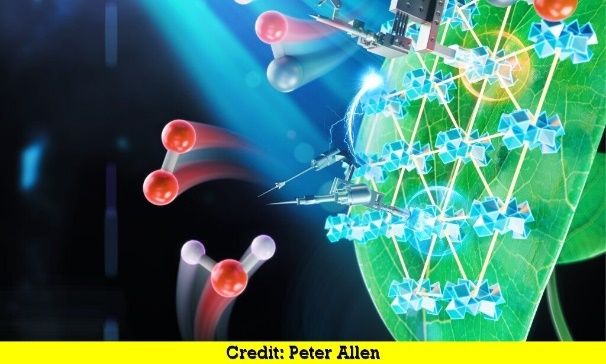 For the past two centuries, humans have relied on fossil fuels for concentrated energy; hundreds of millions of years of photosynthesis have been packed into a convenient, energy-dense substance. But that supply is finite, and fossil fuel consumption has a tremendous negative impact on Earth’s climate. A Nature Catalysis study from six chemists at the University of Chicago, USA, led by Wenbin Lin, shows an innovative new system for artificial photosynthesis, which is more productive than previous artificial systems by an order of magnitude. Unlike regular photosynthesis, which produces carbohydrates from carbon dioxide and water, artificial photosynthesis could produce ethanol, methane, or other fuels.
For the past two centuries, humans have relied on fossil fuels for concentrated energy; hundreds of millions of years of photosynthesis have been packed into a convenient, energy-dense substance. But that supply is finite, and fossil fuel consumption has a tremendous negative impact on Earth’s climate. A Nature Catalysis study from six chemists at the University of Chicago, USA, led by Wenbin Lin, shows an innovative new system for artificial photosynthesis, which is more productive than previous artificial systems by an order of magnitude. Unlike regular photosynthesis, which produces carbohydrates from carbon dioxide and water, artificial photosynthesis could produce ethanol, methane, or other fuels.
The trouble is that photosynthesis is built to create carbohydrates, which are great for fuelling us, but not our cars, which need much more concentrated energy. So, researchers looking to create alternatives to fossil fuels have to re-engineer the process to create more energy-dense fuels, such as ethanol or methane. Lin and his lab team thought that they might try adding something that artificial photosynthesis systems to date have not included: amino acids. The breakthrough could also be applied widely to other chemical reactions; you need to make a lot of fuel for it to have an impact, but much smaller quantities of some molecules, such as the starting materials to make pharmaceutical drugs and nylons, among others, could be very useful. Even with the significantly improved performance, artificial photosynthesis has a long way to go before it can produce enough fuel to be relevant for widespread use.
Access the abstract at https://www.nature.com/articles/s41929-022-00865-5
Related articles at https://www.nature.com/articles/s43016-022-00530-x
4. Genetic duplication governs nitrogen fixation symbiosis between legumes, bacteria
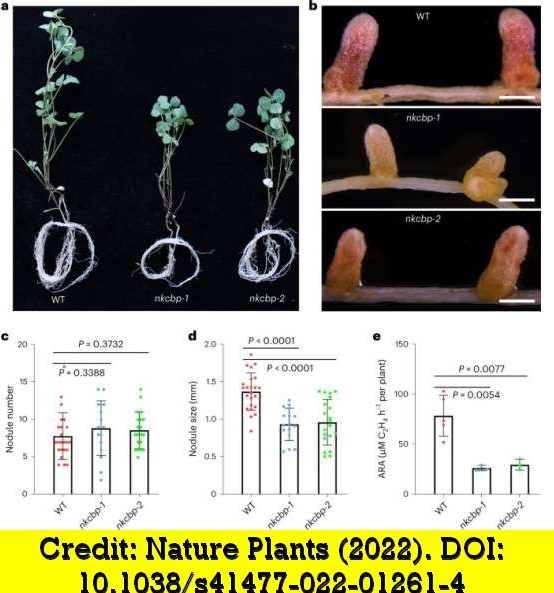
The processes that govern the formation of symbiotic structures between nitrogen-fixing bacteria and legumes in the latter’s roots remain a mystery to science, but researchers from the Chinese Academy of Sciences, Beijing, China, led by Zhaosheng Kong, have recently discovered that a duplication of the genes is playing a key role. When plants, animals, fungi, bacteria, or other organisms suffer from a lack of nitrogen, they will certainly die. Many plants can take ammonia synthesized by nitrogen-fixing bacteria, and other organisms, including animals, can eat those plants or animals that have eaten those plants and thereby obtain nitrogen “fix”.
There are also some plants, especially legumes such as peas, beans, and lentils, which have a symbiotic relationship with rhizobia, where the bacteria are attached to the cells of some plant roots, forming small nodules. The symbiotic relationship between bacteria and plants consists of rhizomes exchanging some of the ammonia for other nutrients necessary for development. If scientists learn more about the symbiosis between rhizobia and legumes, it may be possible to engineer plants other than vegetables that can form such a symbiosis or even fix nitrogen directly, said Zhaosheng. Although much is known about this symbiosis, much remains mysterious, especially the biochemical process that governs endosymbiosis, that is, how bacteria join the cells of the root nodule of a plant.
Access the abstract at https://www.nature.com/articles/s41477-022-01261-4
5. How ethylene response factors regulate fruit ripening and pathogen response
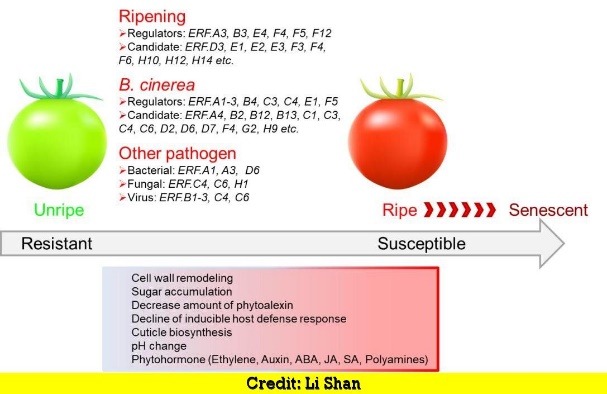 Fleshy fruits that emerge during ripening are more susceptible to bacterial and fungal infections than immature fruits. It is about balancing pathogen resistance. Understanding the processes underlying maturation control and pathogen response may provide new approaches for engineering improvements in fruit quality and pathogen resistance. Ethylene response factors and transcription factors play important roles in various aspects of fruit ripening, and in the resistance of succulent fruits to pathogens. Researchers from the Wuhan Botanical Gardens of the Chinese Academy of Sciences, together with collaborators from the University of Nottingham and Zhejiang University, led by Donald Grierson of the School of Biosciences, University of Nottingham, reviewed and summarized current research on fruit maturation and fruit resistance to pathogens as part of a new approach to investigations on this aspect.
Fleshy fruits that emerge during ripening are more susceptible to bacterial and fungal infections than immature fruits. It is about balancing pathogen resistance. Understanding the processes underlying maturation control and pathogen response may provide new approaches for engineering improvements in fruit quality and pathogen resistance. Ethylene response factors and transcription factors play important roles in various aspects of fruit ripening, and in the resistance of succulent fruits to pathogens. Researchers from the Wuhan Botanical Gardens of the Chinese Academy of Sciences, together with collaborators from the University of Nottingham and Zhejiang University, led by Donald Grierson of the School of Biosciences, University of Nottingham, reviewed and summarized current research on fruit maturation and fruit resistance to pathogens as part of a new approach to investigations on this aspect.
In this review, researchers summarize the status of studies on the ethylene response factor (ERF) that regulates fruit ripening and responses to infection by several fungal pathogens, including a systematic ERF transcriptome analysis of fungal grey mould infection of tomato, caused by Botrytis cinerea. The authors conclude that this deepening understanding of the function of ERFs in fruit ripening and pathogen responses may identify novel approaches for engineering transcriptional regulation to improve fruit quality and pathogen resistance.
Access the full paper at https://www.mdpi.com/2073-4409/11/16/2484
6. Using synthetic genetic circuits as a means of reprogramming plant roots
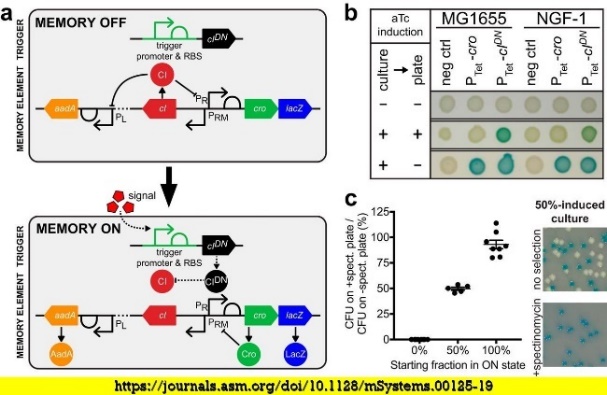 Controlling the activity of genes is an important step in engineering plants for improved bioenergy crops. The expression of synthetic genes is programmed in the form of Boolean logic gates, which work just like computer circuits. Using synthetic gene circuits, researchers at Stanford University, Stanford, USA, led by Jennifer Brophy, have successfully created predictable, novel fluorescent protein expression patterns. This research developed synthetic genes that can be combined to achieve specific patterns of gene expression within the plant. Such synthetic gene circuits can regulate gene expression in plants; to achieve that, researchers have adapted many bacterial gene regulators that are used as synthetic activators or repressors of plant gene expression, also known as transcription factors.
Controlling the activity of genes is an important step in engineering plants for improved bioenergy crops. The expression of synthetic genes is programmed in the form of Boolean logic gates, which work just like computer circuits. Using synthetic gene circuits, researchers at Stanford University, Stanford, USA, led by Jennifer Brophy, have successfully created predictable, novel fluorescent protein expression patterns. This research developed synthetic genes that can be combined to achieve specific patterns of gene expression within the plant. Such synthetic gene circuits can regulate gene expression in plants; to achieve that, researchers have adapted many bacterial gene regulators that are used as synthetic activators or repressors of plant gene expression, also known as transcription factors.
Using a transient expression system, the researchers demonstrated that synthetic transcription factors and their target DNA sequences can drive specific and tunable regulation of gene expression. To implement synthetic gene circuits in a multicellular context, researchers used Arabidopsis roots as a model system, in which endogenous promoters drive tissue-specific expression of synthetic transcription factors. Gene circuits created new expression patterns resulting from successful logical operations. These results show that it is now possible to program gene expression in plant cell types using genetic circuits, providing a road map for designing more sustainable bioenergy crops.
For more, see https://www.sciencedaily.com/releases/2022/10/221026122730.htm
Access the abstract at https://www.scibence.org/doi/abs/10.1126/science.abo4326?cookieSet=1
7. Should maize farmers in sub-Saharan Africa store or sell their grain?
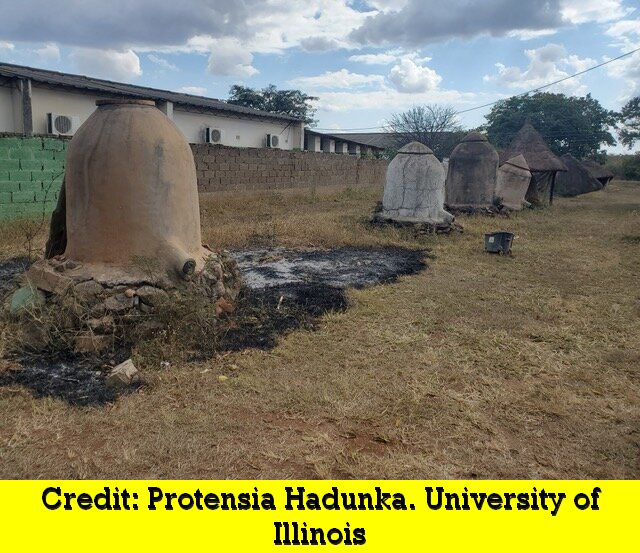 Many maize farmers in sub-Saharan Africa sell their crops during harvest because they need money to cover expenses. Lila Cardell of USDA Economic Research Service, Washington, D.C., and Hope Michelson from the University of Illinois at Urbana-Champaign, Urbana, USA, analysed corn prices in more than a thousand sub-Saharan African markets over 20 years. They found that while corn prices rise after the harvest season, farmers cannot fully predict whether prices are likely to rise or fall. “There has long been an assumption in the agricultural development literature that grain prices in these rural grain markets always rise after harvest,” notes Michelson.
Many maize farmers in sub-Saharan Africa sell their crops during harvest because they need money to cover expenses. Lila Cardell of USDA Economic Research Service, Washington, D.C., and Hope Michelson from the University of Illinois at Urbana-Champaign, Urbana, USA, analysed corn prices in more than a thousand sub-Saharan African markets over 20 years. They found that while corn prices rise after the harvest season, farmers cannot fully predict whether prices are likely to rise or fall. “There has long been an assumption in the agricultural development literature that grain prices in these rural grain markets always rise after harvest,” notes Michelson.
They found that in certain regions, corn is grown and harvested mostly according to the same schedule. Many farmers also sell at the same time, because then the buyers are ready, and the bills must be paid on the farm. Hence, a lot of corn comes on the market at the same time, resulting in a sharp drop in selling prices. Since prices tend to rise throughout the year and peak before harvest, small farmers can buy back corn from the market for a few months. Because the market is unpredictable, farmers must guess whether it makes sense to sell or store the grain. The researchers conclude that other mechanisms, such as forward contracts or multiyear credit, may be necessary to mitigate downside price risk.
Access the full paper at https://onlinelibrary.wiley.com/doi/10.1111/ajae.12343
Potential Crops/Technologies/Concepts
1. ‘Perennial’ rice has potential gains—and some risks
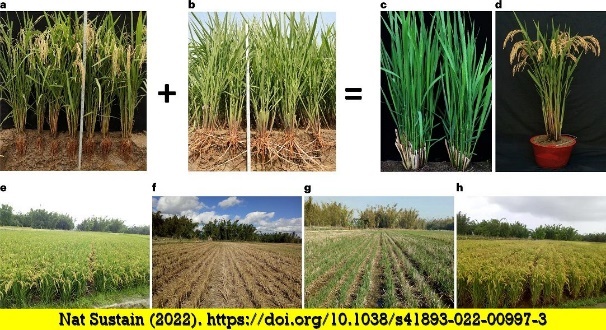 Here we continue the story on perennial rice (See item 2 under Potential Crops/Technologies/Concepts in ATN 45, 15 Nov 2022). After more than 9,000 years in cultivation, annual paddy rice is now available as a long-lived perennial. The advancement means farmers can plant just once and reap up to eight harvests without sacrificing yield. The largest real-world trial of such a crop (perennial rice grown in China) shows promise. Researchers led by Len Wade of the University of Queensland, Brisbane, Australia, and Fengyi Hu of Yunnan University, Kunming, China, have found that perennial rice can yield as bountiful a harvest as traditional crops planted annually, benefiting the soil, and saving smallholder farmers significant labour and costs. However, it is yet to be seen whether perennial rice will become widespread. It took decades to improve the progeny, and in 2018, a variety called Perennial Rice 23 began to be sold to Chinese farmers. Each year after that, the management fee for perennial rice is halved. The biggest beneficiaries of labour savings are likely to be women and children, who do most of the transplanting of rice seedlings in many rice-growing countries.
Here we continue the story on perennial rice (See item 2 under Potential Crops/Technologies/Concepts in ATN 45, 15 Nov 2022). After more than 9,000 years in cultivation, annual paddy rice is now available as a long-lived perennial. The advancement means farmers can plant just once and reap up to eight harvests without sacrificing yield. The largest real-world trial of such a crop (perennial rice grown in China) shows promise. Researchers led by Len Wade of the University of Queensland, Brisbane, Australia, and Fengyi Hu of Yunnan University, Kunming, China, have found that perennial rice can yield as bountiful a harvest as traditional crops planted annually, benefiting the soil, and saving smallholder farmers significant labour and costs. However, it is yet to be seen whether perennial rice will become widespread. It took decades to improve the progeny, and in 2018, a variety called Perennial Rice 23 began to be sold to Chinese farmers. Each year after that, the management fee for perennial rice is halved. The biggest beneficiaries of labour savings are likely to be women and children, who do most of the transplanting of rice seedlings in many rice-growing countries.
A selection, with strong perenniality, high yield, and good grain quality, was released as Yunda107 in China in 2020, and as NARORICE-1 (PR107) in Uganda in 2021. This was the result of the successful breeding of perennial rice to evaluate its effectiveness and potential, in which annual Asian rice (Oryza sativa) was bred with its perennial African relative, O. longstaminata. Perennial irrigated rice from one plantation produced grain in eight consecutive crops over four years, with yields higher than from transplanted annual rice, which required additional labour and seeds. Four years of perennial rice cultivation resulted in the accumulation of organic carbon and nitrogen in the soil, and it increased the pH of the soil and the utilization capacity of plants. The researchers also noted potential risks, such as a build-up of weeds, fungi, and other pathogens in the fields. Insects can persist in the stubble after harvest, and they can then transmit viruses when they feed on the regenerating sprouts in the spring. They also note that it is more work to resow the perennial rice when its yield falters because its larger and deeper roots need to be killed. The potential benefits—and any downsides—will soon come into sharper focus. The perennial rice is being tried in 17 countries in Asia and Africa.
For more, see https://www.science.org/content/article/perennial-rice-saves-time-and-money-comes-risks and https://phys.org/news/2022-11-farmers-china-uganda-high-yielding-cost-saving.html?utm_source=nwletter&utm_medium=email&utm_campaign=%E2%80%A6%201/4
Access the full paper at https://www.nature.com/articles/s41893-022-00997-3
2. New gene discovery sows hope of drought-resilient wheat
Reduced height, or semi-dwarf, wheat varieties with improved drought resilience may soon be grown in fields across the globe, following an exciting scientific discovery. Researchers led by Philippa Borrill from the John Innes Center for Resilient Wheat, in collaboration with an international team of scientists, have 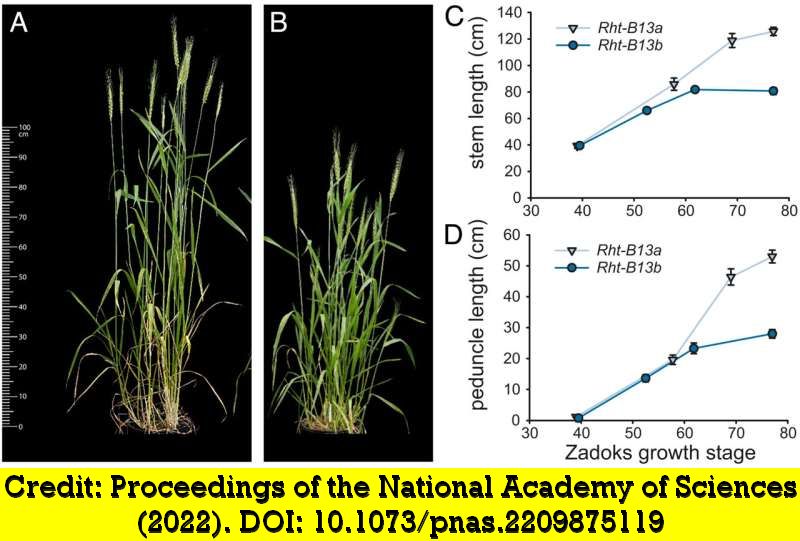 discovered a new height-reducing gene, Rht13, which means that seeds can be planted deeper into the soil, thus providing moisture without damaging the seed. Wheat varieties with the Rht13 gene could be rapidly bred into existing wheat varieties so that farmers can grow short wheat even in drier conditions. “We have discovered a new mechanism to produce short wheat varieties, without the disadvantages associated with traditional semi-dwarf genes. Discovering the gene, its effect, and its precise location in the wheat genome means we can provide breeders with the ideal genetic marker to breed more climate-tolerant wheat,” Borrill says.
discovered a new height-reducing gene, Rht13, which means that seeds can be planted deeper into the soil, thus providing moisture without damaging the seed. Wheat varieties with the Rht13 gene could be rapidly bred into existing wheat varieties so that farmers can grow short wheat even in drier conditions. “We have discovered a new mechanism to produce short wheat varieties, without the disadvantages associated with traditional semi-dwarf genes. Discovering the gene, its effect, and its precise location in the wheat genome means we can provide breeders with the ideal genetic marker to breed more climate-tolerant wheat,” Borrill says.
The recently discovered dwarf gene Rht13 solves the seedling emergence problem with existing semi-dwarf wheat varieties because the gene acts in tissues above the stem of wheat. That discovery has enabled recent advances in wheat genome research in 2020 with the publication of Pan Genome, an atlas of 15 wheat genomes collected from around the world. Experiments testing the effect of the gene in several transgenic wheat plants confirmed that the Rht13 variety represents a new class of short-length genes more often associated with disease resistance, compared to the widely used Green Revolution genes. This discovery opens avenues to use auto-active, nucleotide-binding, site leucine-rich repeat (NBS-LRR) genes as semi-dwarfing genes in a range of crop species, and to apply Rht13 in wheat breeding programs using a perfect genetic marker.
Access the full paper at https://www.pnas.org/doi/10.1073/pnas.2209875119
3. Infarm demonstrates the potential of indoor-grown wheat
Wheat provides a large part of the world’s population with their daily energy needs, and it is a significant source of protein, accounting for almost 40% of daily protein consumption in some regions. Wheat is grown on a larger area than any other crop and the unstable environment is expected to reduce yield per hectare. To be able to meet the need of the growing population and counter the negative effects of a warming environment on wheat yield, there is a need to increase the wheat yield, which is now made possible indoors with a controlled environment. 
Infarm, a vertical farming company and co-host of the food systems pavilion at COP 27, has successfully produced wheat indoors. Infarm’s goal is to be the first vertical farming company that engages in basic crop production in a controlled environment. According to Guy Galonska, CTO, and co-founder of Infarm, to continue feeding the world’s growing population, we must achieve higher yields, which Infarm has shown to be possible with wheat, using controlled environmental agriculture. The results are significant in comparison to the average yield of wheat production, which is 4.5 tonnes per hectare per year, and which strongly depends on the weather and season. Thus, wheat can also be successfully cultivated indoors as a climate-resistant option. Record yields can potentially be increased by another 50% in the coming years using improved genetics, equipment, and optimized growing environments.
For more, see https://www.hortidaily.com/article/9476066/infarm-demonstrates-potential-of-indoor-grown-wheat/
4. Salt-tolerant bacteria can fight fungal attacks on chilli
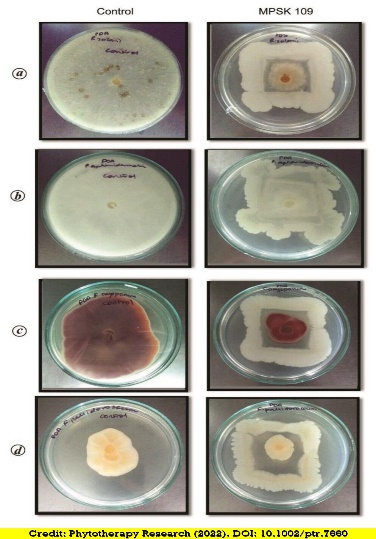 Salt-tolerant bacteria found in salt containers can be used to control fungal attacks on chilli, India’s main export crop, according to a new study by Sudip Kumar Mandal and colleagues at Goa University, India. They found that salt-tolerant bacteria can be used to combat fungal pathogens that thrive due to increased soil salinity. Of all the abiotic factors, soil salinization is the most damaging, and it is considered a major limiting factor to agricultural productivity and food security. Mandal and colleagues screened the 196 bacteria isolated from the salt pans of Goa for their antifungal activity. They found that halotolerant isolates of the six types of bacteria could grow in a wide range of pH, temperature, and NaCl concentration, indicating their ability to survive and reproduce under different soil dynamics.
Salt-tolerant bacteria found in salt containers can be used to control fungal attacks on chilli, India’s main export crop, according to a new study by Sudip Kumar Mandal and colleagues at Goa University, India. They found that salt-tolerant bacteria can be used to combat fungal pathogens that thrive due to increased soil salinity. Of all the abiotic factors, soil salinization is the most damaging, and it is considered a major limiting factor to agricultural productivity and food security. Mandal and colleagues screened the 196 bacteria isolated from the salt pans of Goa for their antifungal activity. They found that halotolerant isolates of the six types of bacteria could grow in a wide range of pH, temperature, and NaCl concentration, indicating their ability to survive and reproduce under different soil dynamics.
Chillies were first brought to Asia by the 16 century Portuguese and Spanish explorers, and the cultivation of chilli pepper is distributed on all continents, especially Capsicum frutescens, or chilli pepper, and C. annuum, which includes sweet pepper, cayenne, friggitello, jalapeno, bell pepper, and serrano varieties. “C. annuum has been used as a tonic, antiseptic, and stimulant, to treat dyspepsia, appetite, and flatulence, and to improve digestion and circulation,” says a Phytotherapy Research study. However, chilli peppers are susceptible to several fungal pathogens that affect harvest, including Cercospora capsici and Alternaria solani, which damage the leaves, and Colletotrichum sp., which causes fruit rot in chilli. The study offers potential for bacterial biocontrol agents that can compete with the pathogens and promote crop growth, especially under conditions of extreme soil salinity.
Access the abstract at https://onlinelibrary.wiley.com/doi/10.1002/ptr.7660
5. Adaptive variation in wild relatives of modern maize has potential use in breeding
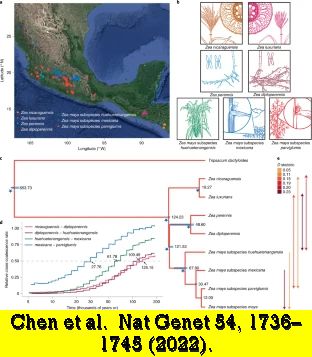 Maize is widely cultivated worldwide, but it has lost much of its genetic diversity, owing to population bottlenecks during domestication and breeding. The potential of teosinte as a source of beneficial diversity in maize is still poorly understood. Lu Chen and colleagues at the Chinese Academy of Sciences, Beijing, in collaboration with US researchers, report a high-resolution map of genomic variation that expands the sequence profiles of maize and its wild relatives in the genus Zea, yielding many adaptive alleles missing in maize, which can speed up reproduction by restoring genetic diversity.
Maize is widely cultivated worldwide, but it has lost much of its genetic diversity, owing to population bottlenecks during domestication and breeding. The potential of teosinte as a source of beneficial diversity in maize is still poorly understood. Lu Chen and colleagues at the Chinese Academy of Sciences, Beijing, in collaboration with US researchers, report a high-resolution map of genomic variation that expands the sequence profiles of maize and its wild relatives in the genus Zea, yielding many adaptive alleles missing in maize, which can speed up reproduction by restoring genetic diversity.
Nucleotide diversity is greater in teosinte taxa than in the much larger group of maize lineages, and genetic divergence between teosintes is often lower than between native maize and teosintes, consistent with a historical decline in diversity during domestication and breeding. Further work is needed to identify the possible function of selected non-coding regions in adaptation to different environments, and to determine if the genes for adaptation thus identified could be used to accelerate modern maize breeding. The genomic and allelic repertoire and genealogy of teosintes are of special interest and importance because teosintes were domesticated on maize and are from different regions of origin.
For more, see https://www.nature.com/articles/s41588-022-01186-w
Access the abstract at https://www.nature.com/articles/s41588-022-01184-y
6. Smart breeding is driven by big data, artificial intelligence, and integrated genomic-environs prediction
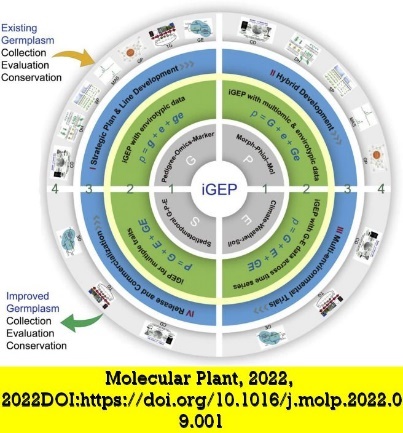
The first paradigm of plant breeding involves phenotypic observation based on direct selection, followed by predictive breeding, using statistical models for quantitative traits, constructed based on genetic experimental design and, more recently, by incorporation of molecular marker genotypes. Phenotypes can be predicted more precisely by training a model using data collected from multiple sources, including spatiotemporal omics (genomics, phenomics, and enviromics across time and space).
Integration of 3D information# profiles (G-P-E), each with multi-dimensionality, provides predictive breeding with both tremendous opportunities and great challenges. Researchers from CYMMIT, led by Yunbi Xu, review innovative technologies for predictive breeding and propose an intelligent breeding system, Integrated Genome-Environment Prediction (iGEP), which is an extension of genome prediction using integrated multiomics, big data technology, and artificial intelligence (for machine and deep learning). A prediction-based crop transformation strategy is then proposed at both the macro (individual, population, and species) and micro (gene, metabolism, and network) scales. Finally, the authors discuss how to turn smart breeding into genetic gain through integrative breeding platforms and open-source breeding initiatives.
For more, see https://www.cell.com/molecular-plant/fulltext/S1674-2052(22)00295-7
News:
1. Cover crops can lower yields, according to a new study
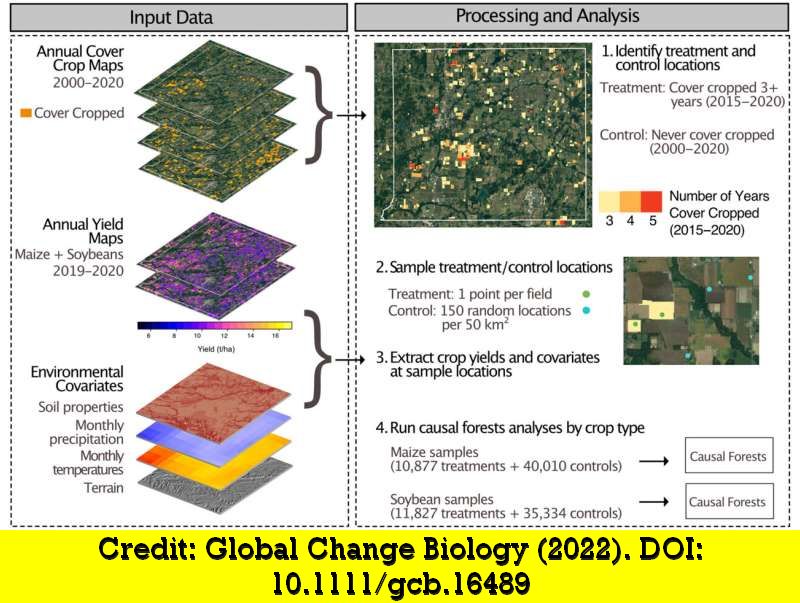 The reality of planting cover crops during the off-season—a much-touted and subsidized approach to climate change mitigation—is quite complicated, according to Jillian Deines and colleagues of the Stanford University-led research effort. However, previous work based on experimental plots or crop modelling indicates cover crops may reduce crop yields. Researchers found that corn production losses were higher in fields with better soil, cooler mid-season temperatures, and less spring rainfall. The average soybean yield loss was 3.5%, with greater effects in fields with warmer June temperatures, lower spring and fall precipitation, and poorer soils. These results suggest a need to improve cover crop management to reduce yield payments and a need to target subsidies based on yield effects. Additional research can help guide this implementation by showing, among other things, how alternatives to rye, the most used cover crop in the US corn belt, can lead to higher staple yields in some regions.
The reality of planting cover crops during the off-season—a much-touted and subsidized approach to climate change mitigation—is quite complicated, according to Jillian Deines and colleagues of the Stanford University-led research effort. However, previous work based on experimental plots or crop modelling indicates cover crops may reduce crop yields. Researchers found that corn production losses were higher in fields with better soil, cooler mid-season temperatures, and less spring rainfall. The average soybean yield loss was 3.5%, with greater effects in fields with warmer June temperatures, lower spring and fall precipitation, and poorer soils. These results suggest a need to improve cover crop management to reduce yield payments and a need to target subsidies based on yield effects. Additional research can help guide this implementation by showing, among other things, how alternatives to rye, the most used cover crop in the US corn belt, can lead to higher staple yields in some regions.
For more, see https://phys.org/news/2022-11-crops-yields.html?utm_source=nwletter&utm_medium=email&utm_campaign=daily-nwletter
Access the full paper at https://onlinelibrary.wiley.com/doi/10.1111/gcb.16489
2. Greenhouse gas emissions reduced in sustainable rice cultivation
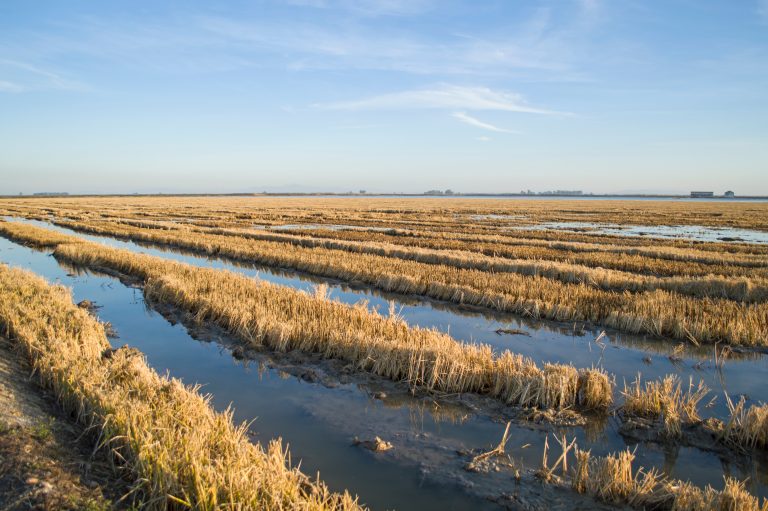 As part of an ongoing project to improve the sustainability of rice cultivation in Seville, Spain’s largest rice-growing region, a joint project between Mars Food, Herba Ricemills, and Danone has shown that greenhouse gas (GHG) emissions can be significantly reduced. The ORYZONTE project, launched in 2018, used alternative irrigation and drying techniques, and it achieved up to 63% reduction in GHG emissions from rice fields in the province of Seville. The ORYZONTE project sampled and analysed greenhouse gas emissions from three commercial rice fields, each with a different water management scenario. Most rice fields are cultivated under flooded conditions, which means that they are a major source of anthropogenic GHG, namely methane, a common gas in rice cultivation. Overall, project results showed that the implementation of specific mitigation practices effectively reduced GHG emissions from rice fields in Seville. The ORYZONTE project now aims to work with rice farmers in the Spanish region to educate them about the feasibility of greenhouse gas-saving practices, such as mid-season drainage, in their commercial fields.
As part of an ongoing project to improve the sustainability of rice cultivation in Seville, Spain’s largest rice-growing region, a joint project between Mars Food, Herba Ricemills, and Danone has shown that greenhouse gas (GHG) emissions can be significantly reduced. The ORYZONTE project, launched in 2018, used alternative irrigation and drying techniques, and it achieved up to 63% reduction in GHG emissions from rice fields in the province of Seville. The ORYZONTE project sampled and analysed greenhouse gas emissions from three commercial rice fields, each with a different water management scenario. Most rice fields are cultivated under flooded conditions, which means that they are a major source of anthropogenic GHG, namely methane, a common gas in rice cultivation. Overall, project results showed that the implementation of specific mitigation practices effectively reduced GHG emissions from rice fields in Seville. The ORYZONTE project now aims to work with rice farmers in the Spanish region to educate them about the feasibility of greenhouse gas-saving practices, such as mid-season drainage, in their commercial fields.
3. Tracing tomatoes’ health benefits to gut microbes
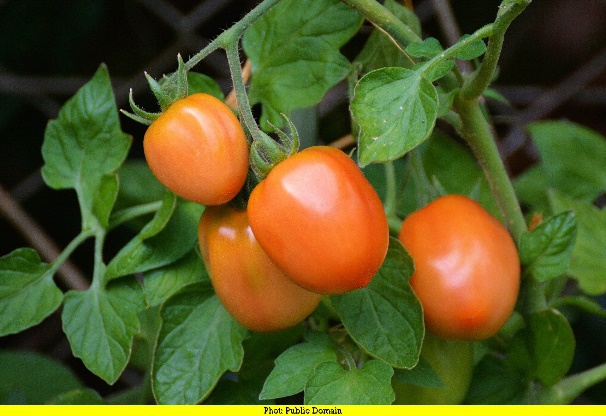 Two weeks of a tomato-rich diet increased gut microbial diversity and made the gut bacterial profile more favourable in young pigs, researchers found. Ten recently weaned control piglets were fed a standard diet, and 10 piglets were fed a fine-tuned standard diet with freeze-dried tomato powder as 10% of their diet. The results showed two main changes in the microbiomes of pigs fed a tomato-rich diet: (1) the species diversity of their gut microbes increased; and (2) the concentrations of two types of bacteria common in mammalian microbiomes shifted to a more favourable profile.
Two weeks of a tomato-rich diet increased gut microbial diversity and made the gut bacterial profile more favourable in young pigs, researchers found. Ten recently weaned control piglets were fed a standard diet, and 10 piglets were fed a fine-tuned standard diet with freeze-dried tomato powder as 10% of their diet. The results showed two main changes in the microbiomes of pigs fed a tomato-rich diet: (1) the species diversity of their gut microbes increased; and (2) the concentrations of two types of bacteria common in mammalian microbiomes shifted to a more favourable profile.
Tomatoes make up about 22% of vegetable consumption in the Western diet (Note: although world-wide figures are not available for comparison, anecdotal information indicates that tomatoes make up a large amount), and previous studies have linked tomato consumption to a reduced risk of various diseases, such as cardiovascular disease and certain cancers. The effect of tomatoes on the gut microbiome is still a mystery, and Jessica Cooperstone of Food Science and Technology, Ohio State University, Columbus, Ohio, USA, says these findings in pigs —whose digestive tracts are more like those of humans than is the case with rodents—suggest it is an avenue worth exploring.
Access the full paper at https://journals.asm.org/doi/10.1128/spectrum.02506-22
4. Amid food and climate crises, investing in sustainable food cold chains is crucial
A United Nations report indicates that as food insecurity and global warming worsen, governments, international development partners, and industry must invest in sustainable food cold chains to reduce hunger, provide livelihoods for communities, 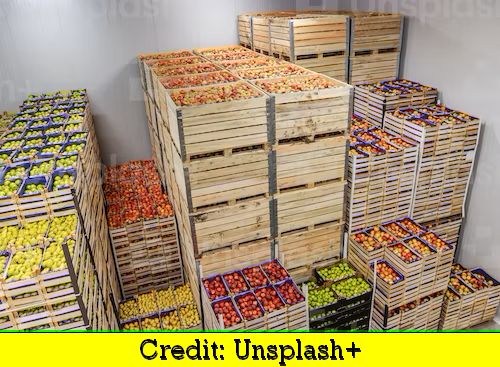 and adapt to climate change. The report, ‘Sustainable Food Cold Chains,’ by the United Nations Environment Program (UNEPP) and the Food and Agriculture Organization (FAO), says that food cold chains are critical to the challenge to feed two billion more. The chains can help harness the resilience of rural communities, while avoiding increases in greenhouse gases. “At a time when the international community must act to solve the climate and food crises, sustainable food cold chains can make a huge difference,” said Inger Andersen, Director-General of the UN Environment Programme. Cold stores help reduce food waste, improve food security, slow greenhouse gas emissions, create jobs, reduce poverty, and build resilience. The adoption of the Kigali Amendment to the Montreal Protocol and the Rome Declaration, “The Contribution of the Montreal Protocol to Sustainable Cold Chain Development to Reduce Food Waste,” offers a unique opportunity to accelerate the adoption of sustainable food cold chains.
and adapt to climate change. The report, ‘Sustainable Food Cold Chains,’ by the United Nations Environment Program (UNEPP) and the Food and Agriculture Organization (FAO), says that food cold chains are critical to the challenge to feed two billion more. The chains can help harness the resilience of rural communities, while avoiding increases in greenhouse gases. “At a time when the international community must act to solve the climate and food crises, sustainable food cold chains can make a huge difference,” said Inger Andersen, Director-General of the UN Environment Programme. Cold stores help reduce food waste, improve food security, slow greenhouse gas emissions, create jobs, reduce poverty, and build resilience. The adoption of the Kigali Amendment to the Montreal Protocol and the Rome Declaration, “The Contribution of the Montreal Protocol to Sustainable Cold Chain Development to Reduce Food Waste,” offers a unique opportunity to accelerate the adoption of sustainable food cold chains.
For more, see https://phys.org/news/2022-11-food-climate-crises-investing-sustainable.html?utm_source=nwletter&utm_medium=email&utm_campaign=daily-n%E2%80%A6%201/4 and
5. Climate action at COP
 From 6 to 18 November, Heads of State, ministers, and negotiators, along with climate activists, mayors, civil society representatives, and CEOs met in the Egyptian coastal city of Sharm el-Sheikh for the largest annual gathering on climate action. The 27th Conference of the Parties to the United Nations Framework Convention on Climate Change—COP27 (https://unfccc.int/cop27)— was expected to deliver action on an array of issues critical to tackling the climate emergency—from urgently reducing greenhouse gas emissions, building resilience, and adapting to the inevitable impacts of climate change, to delivering on the commitments to finance climate action in developing countries. Although some progress was made, on several counts the meeting has not delivered fully satisfactory outcomes. Rich countries are also under pressure to finally fulfil promises to provide $100 billion a year to help developing countries green their economies and adapt to future impacts. The implications of COP27 will be felt for decades to come, for better or worse. Discussions highlighted nature’s pivotal role in tackling the climate crisis and the need for ameliorative human intervention.
From 6 to 18 November, Heads of State, ministers, and negotiators, along with climate activists, mayors, civil society representatives, and CEOs met in the Egyptian coastal city of Sharm el-Sheikh for the largest annual gathering on climate action. The 27th Conference of the Parties to the United Nations Framework Convention on Climate Change—COP27 (https://unfccc.int/cop27)— was expected to deliver action on an array of issues critical to tackling the climate emergency—from urgently reducing greenhouse gas emissions, building resilience, and adapting to the inevitable impacts of climate change, to delivering on the commitments to finance climate action in developing countries. Although some progress was made, on several counts the meeting has not delivered fully satisfactory outcomes. Rich countries are also under pressure to finally fulfil promises to provide $100 billion a year to help developing countries green their economies and adapt to future impacts. The implications of COP27 will be felt for decades to come, for better or worse. Discussions highlighted nature’s pivotal role in tackling the climate crisis and the need for ameliorative human intervention.
For more, see https://phys.org/news/2022-11-cop27-experts.html?utm_source=nwletter&utm_medium=email&utm_campaign=daily-nwletter and https://foodtank.com/news/2022/11/dispatch-from-the-u-n-climate-change-conference-friday-nov-eighteenth/ and https://phys.org/news/2022-11-climate-overtime.html?utm_source=nwletter&utm_medium=email&utm_campaign=daily-nwletter and https://www.weforum.org/agenda/2022/11/10-key-takeaways-cop27-nature-critical-role/ and https://www.nature.com/articles/d41586-022-03573-z
6. India in Africa: The changing face of South-South cooperation
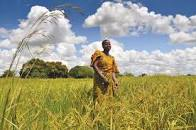
South-South Cooperation aims to create a framework for cooperation between post-colonial countries at a similar stage of development: the independence of India in 1947 has facilitated the exchange of knowledge, technology, and experience with countries in Africa. Indian officials describe India’s Africa Strategy, originally conceived as a partnership between equals, as an ongoing demand-driven exercise, which benefits both Indian and African states. The Export-Import Bank of India now offers buyer credit to foreign governments to purchase additional goods and services for projects financed by India. Illustrative examples include the Asia-Africa Growth Corridor, developed by Japan, India, and several African countries, to improve infrastructure and digitization; Indian Trade and Investment in Africa, funded by the K Commonwealth and Development Agency; and Future India Triangular Training Program for Agricultural Research in Africa, funded by USAID and India. The rise of India, China, and other global South donors has created a polycentric global landscape, which offers African policymakers viable alternatives to the global North. (Results from a project entitled ‘India’s Footprint in Africa: South-South Cooperation and the Politics of Gifts and Reciprocity,’ funded by the Research Council of Norway)
For more, see https://africanarguments.org/2022/11/india-in-africa-the-changing-face-of-south-south-cooperation/
7. This ancient grain-sowing method could be farming’s future
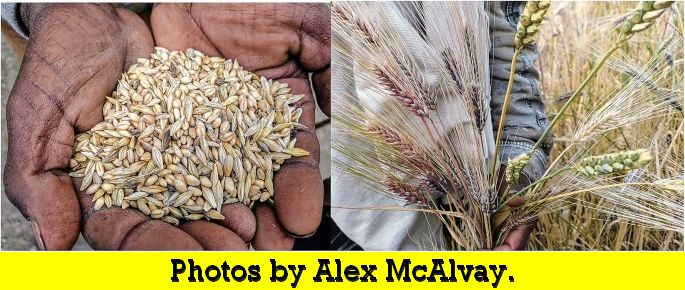 Zamede Asfaw, a graduate student in botany who served as a field interpreter for Alex McAlvay, the lead author, in interviews with more than 100 farmers, says that because of the national embrace of monocultures, new farmers are not learning the art of mixed crops. From a farmer’s point of view, he understands the appeal of the profitable proposition of growing certain crops, but he thinks that “the scientific community should produce something better. Together with McAlvay and like-minded people in Georgia and small experimental farms in Poland, Finland, and elsewhere, Zamede hopes to inspire a wider appreciation of olives, from farmers in the fields to cities that buy artisan mixed bread. Cereal bread Maslin’s renaissance may be especially useful now, as farmers around the world struggle with modern monoculture, growing populations, and soil degradation from a changing climate. “It’s about putting the power back in the hands of farmers who understand the land, farming, and management”, says Malleson, whose family is in farming and who feels close to the subject. Zamede continues to encourage Ethiopian farmers to maintain the maslin tradition learned at a young age, and he hopes more people around the world will adopt the grain mixes our ancestors used.
Zamede Asfaw, a graduate student in botany who served as a field interpreter for Alex McAlvay, the lead author, in interviews with more than 100 farmers, says that because of the national embrace of monocultures, new farmers are not learning the art of mixed crops. From a farmer’s point of view, he understands the appeal of the profitable proposition of growing certain crops, but he thinks that “the scientific community should produce something better. Together with McAlvay and like-minded people in Georgia and small experimental farms in Poland, Finland, and elsewhere, Zamede hopes to inspire a wider appreciation of olives, from farmers in the fields to cities that buy artisan mixed bread. Cereal bread Maslin’s renaissance may be especially useful now, as farmers around the world struggle with modern monoculture, growing populations, and soil degradation from a changing climate. “It’s about putting the power back in the hands of farmers who understand the land, farming, and management”, says Malleson, whose family is in farming and who feels close to the subject. Zamede continues to encourage Ethiopian farmers to maintain the maslin tradition learned at a young age, and he hopes more people around the world will adopt the grain mixes our ancestors used.
Access the full paper at https://link.springer.com/article/10.1007/s13593-022-00832-1
8. Entomologists issue warning about effects of climate change on insects
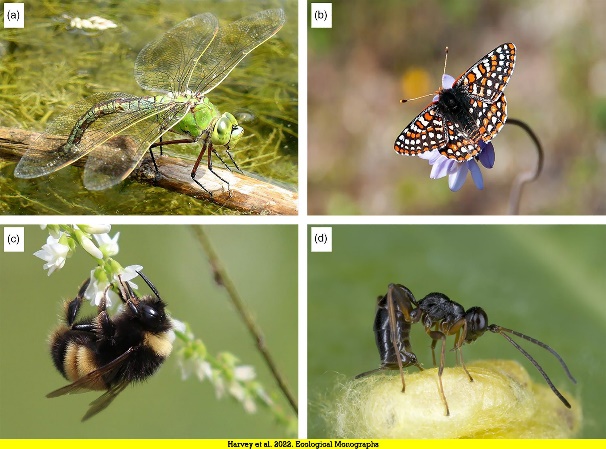 In a new scientific review, a group of 70 scientists from 19 countries warned that if actions to protect insects from climate change are not taken, it will dramatically weaken our ability to build a sustainable future, based on healthy, functioning ecosystems. With research from around the world, the group painted a grim picture of climate-change related short- and long-term effects on insects, many of which have been declining for decades. One way insects deal with climate change is by changing their territory or settling permanently in areas with lower temperatures. According to a study cited by Espíndola and other researchers, almost half of insect species will decrease by 50% or more if the planet warms up to 3.2°C. If warming is limited to 1.5 degrees—the goal of the global Paris agreement on climate change—6% of insects will be affected. On the other hand, climate change could make certain insects more common—at the expense of human health and agriculture.
In a new scientific review, a group of 70 scientists from 19 countries warned that if actions to protect insects from climate change are not taken, it will dramatically weaken our ability to build a sustainable future, based on healthy, functioning ecosystems. With research from around the world, the group painted a grim picture of climate-change related short- and long-term effects on insects, many of which have been declining for decades. One way insects deal with climate change is by changing their territory or settling permanently in areas with lower temperatures. According to a study cited by Espíndola and other researchers, almost half of insect species will decrease by 50% or more if the planet warms up to 3.2°C. If warming is limited to 1.5 degrees—the goal of the global Paris agreement on climate change—6% of insects will be affected. On the other hand, climate change could make certain insects more common—at the expense of human health and agriculture.
Access the full paper at https://esajournals.onlinelibrary.wiley.com/doi/10.1002/ecm.1553
9. Seed-based technology offers peace of mind from sorghum forage risk
Sorghum has served as a food and feeds crop for thousands of years, yet it can become poisonous under drought or freezing conditions. The problem is dhurrin, which breaks down to form prussic acid, also known as hydrogen cyanide. Mitch Tuinstra, research director of the School of Agriculture’s Institute of Plant Sciences, at Purdue University, USA, has developed a dhurrin-free sorghum technology to ease 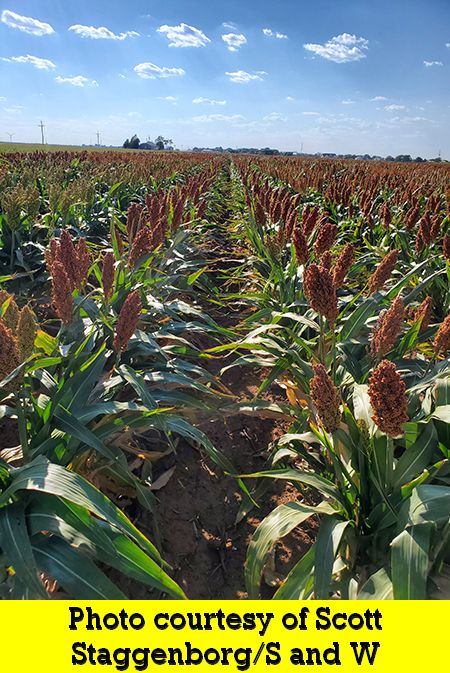 farmers’ minds. “Cyanide poisoning is something ranchers always have to worry about. It does not happen very often. But when it does, it is important. This technology eliminates that risk,” said Brent Bean, director of agronomy for the United Sorghum Checkoff Program in Lubbock, Texas. Farmers still use sorghum as a forage crop because it performs well in high temperatures, tolerates drought, and produces a lot of forage with little feed.
farmers’ minds. “Cyanide poisoning is something ranchers always have to worry about. It does not happen very often. But when it does, it is important. This technology eliminates that risk,” said Brent Bean, director of agronomy for the United Sorghum Checkoff Program in Lubbock, Texas. Farmers still use sorghum as a forage crop because it performs well in high temperatures, tolerates drought, and produces a lot of forage with little feed.
For more, see https://www.purdue.edu/newsroom/releases/2022/Q4/seed-based-technology-offers-peace-of-mind-from-sorghum-forage-risk.html
Events (August 2023):
1. ICABES 2023: International Conference on Agricultural, Biological and Environmental Systems

03-04 August 2023, Montreal, Canada
For more, see https://waset.org/agricultural-biological-and-environmental-systems-conference-in-august-2023-in-montreal
2. ICATSA 2023: International Conference on Agricultural Technology andSustainable Agriculture

03-04 August 2023, Lagos, Nigeria
For more, see https://waset.org/agricultural-technology-and-sustainable-agriculture-conference-in-august-2023-in-lagos
3. ICABD 2023: International Conference on Agriculture and Biotechnological Developments

10—11 August 2023, Barcelona, Spain
For more, see https://waset.org/agriculture-and-biotechnological-developments-conference-in-august-2023-in-barcelona
4. ICABSD 2023: International Conference on Agricultural Biodiversity for Sustainable Development

17-18 August 2023, Istanbul, Türkiye
For more, see https://waset.org/agricultural-biodiversity-for-sustainable-development-conference-in-august-2023-in-istanbul
5. ICPBAAS 2023: International Conference on Plant Breeding in Agriculture and Agricultural Sciences

17-18 August 2023, Budapest, Hungary
For more, see https://waset.org/plant-breeding-in-agriculture-and-agricultural-sciences-conference-in-august-2023-in-budapest
6. ICAPV 2023: International Conference on Advances in Plant Virology

30-31 August 2023, Moscow, Russia
For more, see https://waset.org/advances-in-plant-virology-conference-in-august-2023-in-moscow
Other Topics of Interest
1. By leaving garden waste alone, Danes could store 600,000 tonnes of carbon dioxide per year
2. More biodiversity is not a silver bullet for ecosystem restoration
For more, see https://msutoday.msu.edu/news/2022/biodiversity-ecosystem-restoration
3. Planting trees can save lives, the study of 30-year tree planting campaign finds
For more, see https://phys.org/news/2022-11-trees-year-tree-campaign.html?utm_source=nwletter&utm_medium=email&utm_campaign=daily-nwletter
Access the full paper at https://www.sciencedirect.com/science/article/pii/S0160412022005360?via%3Dihub
4. Government regulation and information presentation may determine palatability of the concept of gene-edited food
Access the full paper at https://phys.org/news/2022-10-palatability-concept-gene-edited-food.html?utm_source=nwletter&utm_medium=email&utm_campaign=daily-nwletter
Access the full paper at https://journals.sagepub.com/doi/10.1177/01622439221123830
5. Israeli formula developed to grow tomatoes in drought
For more, see https://www.hortidaily.com/article/9473194/israeli-formula-developed-to-grow-tomatoes-in-drought/
6. Grafting reduces root-to-shoot cadmium translocation
For more, see https://www.hortidaily.com/article/9474058/research-grafting-reduces-root-to-shoot-cadmium-translocation/ and https://english.cas.cn/newsroom/research_news/earth/202210/t20221031_322399.shtml
7. ARS Researchers develop new rice grains with dazzling color and flavor
For more, see https://tellus.ars.usda.gov/stories/articles/from-staple-to-star/?utm_medium=email&utm_source=govdelivery
8. Pepper variome reveals the history and key loci associated with fruit domestication and diversification (Note: The variome is the whole set of genetic variations found in populations of species that have gone through a relatively short evolution change.)
9. Fertilizers limit pollination by changing how bumblebees sense flowers
Access the full paper at https://academic.oup.com/pnasnexus/article/1/5/pgac230/6814445?login=false
10. A gene from 28 million years ago protects today’s plants against caterpillars
For more, see https://phys.org/news/2022-11-gene-million-years-today-caterpillars.html
Access the abstract at https://elifesciences.org/articles/81050
11. FAO’s methodology for damage and loss assessment in agriculture
For more, see https://www.fao.org/documents/card/en/c/ca6990en
12. Ethiopian crop ‘enset’ identified as climate coping strategy in drought-prone regions
Access the full paper at https://nph.onlinelibrary.wiley.com/doi/10.1002/ppp3.10339
13. Less intensively managed grasslands have higher plant diversity and better soil health, research shows for first time
Access the full paper at https://besjournals.onlinelibrary.wiley.com/doi/10.1002/2688-8319.12191
14. Using honeyscrisp DNA to improve apples to a desirable breed
For more, see https://www.natureworldnews.com/articles/53900/20221027/using-honeyscrisp-dna-improve-apples-desirable-breed.htm
Access the full paper at https://www.ncbi.nlm.nih.gov/pmc/articles/PMC4780794/
15. Can an economics formula save the planet?
16. Renaming Indigenous crops and addressing colonial bias in scientific language
For more, see https://www.cell.com/trends/plant-science/fulltext/S1360-1385(22)00243-6?dgcid=raven_jbs_etoc_email
17. ‘You wait, but nothing comes:’ Honduran farmers at the mercy of climate-change induced drought, floods
18. Jet lagged plants pave the way to first digital plant
For more, see https://phys.org/news/2022-11-jet-lagged-pave-digital.html?utm_source=nwletter&utm_medium=email&utm_campaign=daily-nwletter
Access the full paper at https://academic.oup.com/insilicoplants/article/4/2/diac010/6594971?login=false
19. 7 ways CRISPR gene editing could transform food
For more, see https://geneticliteracyproject.org/2022/11/14/7-ways-crispr-gene-editing-could-transform-food/?utm_source=jeeng and https://www.freethink.com/science/crispr-food
20. Climate change will force farmers to reshuffle what is grown where
Access the abstract at https://www.nature.com/articles/s41586-022-05441-2
21. Forest Declaration Assessment: Are we on track for 2030?
22. Across Africa, water conflict threatens security, health, and the environment
For more, see https://independentmediainstitute.org/across-africa-water-conflict-threatens-security-health-and-the-environment/
23. UN unveils global ‘early warning’ system for disasters at $3 billion
24. Radical collaboration needed for climate adaptation
For more, see https://www.sei.org/about-sei/press-room/collaboration-climate-adaptation/
25. From Japan to Iceland, futuristic vertical farms are starting to bloom
26. When will India approve its first GM food crop?
For more, see https://www.nature.com/articles/d41586-022-03738-w
27. Science misinformation on GMOs reaches quarter of a billion people, study finds
Access the full paper at https://www.tandfonline.com/doi/full/10.1080/21645698.2022.2140568
28. Climate change is costing trillions—and low-income countries are paying the price
For more, see https://www.nature.com/articles/d41586-022-03573-z
29. To improve research collaboration among Land-Grant Universities, Congress should facilitate participation of historically Black and Tribal Colleges and Universities, says new report
Access the full report at https://nap.nationalacademies.org/catalog/26640/enhancing-coordination-and-collaboration-across-the-land-grant-system
30. What is a flash drought? An Earth scientist explains
For more, see https://phys.org/news/2022-11-drought-earth-scientist.html?utm_source=nwletter&utm_medium=email&utm_campaign=daily-nwletter
31. USDA and USAID announce Global Food Security Research Strategy to fight hunger and build sustainable systems
For more, see https://www.usda.gov/media/press-releases/2022/10/19/usda-and-usaid-announce-global-food-security-research-strategy
Access the full paper at https://www.feedthefuture.gov/resource/u-s-government-global-food-security-research-strategy-fy22-26/
